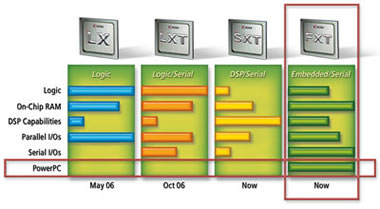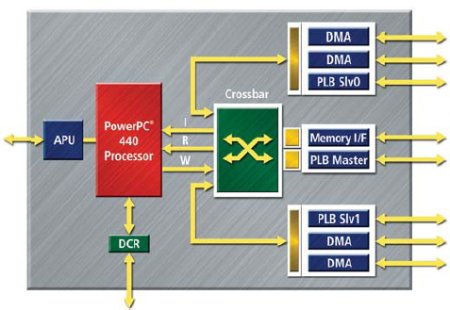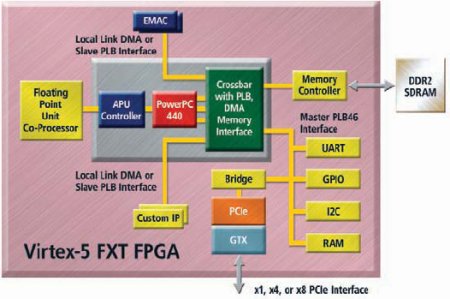High-end FPGA comes with Linux
Apr 1, 2008 — by Eric Brown — from the LinuxDevices Archive — 12 views Xilinx is sampling what appears to be its most powerful FPGA (field-programmable gate array) yet. Designed for high-end communications applications such as wireless base-stations, the PowerPC 440-based Virtex-5 FXT FPGA is the fastest in the company's 65nm Virtex-5 line, with DSP performance of over 190 GMACs.
Xilinx is sampling what appears to be its most powerful FPGA (field-programmable gate array) yet. Designed for high-end communications applications such as wireless base-stations, the PowerPC 440-based Virtex-5 FXT FPGA is the fastest in the company's 65nm Virtex-5 line, with DSP performance of over 190 GMACs.
The Virtex-5 FXT is the fourth in a line of Virtex-5 FPGAs that was launched in May 2006 when the base-level LX model started sampling. This was followed by the LXT and then most recently by the SXT, each of which offered additional performance and functionality (see diagram below). As the only 65nm FPGAs on the market, says Xilinx, they offer 65 percent greater logic capacity and about 30 percent faster performance than 90nm FPGAs, while consuming 35 percent less power.

Virtex-5 comparison chart
The Virtex-5 FXT targets wired and wireless communications, audio/video broadcast equipment, military, aerospace, industrial systems, and other high-end applications. The design is based on one or two embedded PowerPC 440 processor blocks, each of which integrates 32KB instruction and 32KB data caches, delivering up to a claimed 1,100 DMIPS at 550MHz. The blocks are closely integrated with a 5×2 crossbar processor interconnect architecture that is said to enable simultaneous access to I/O and memory. The interconnect architecture includes dedicated master and slave processor local bus interfaces, four DMA ports with separate transmit and receive channels, and a dedicated memory bus interface.

Virtex-5's core hardware
(Click to enlarge)
The FPGA's PLB (processor local bus) architecture handles communications between the processor, crossbar and soft IP logic with 128-bit interfaces. An Auxiliary Processor Control Unit (APU) provides added connectivity for dedicated co-processing engines or custom, user-defined instructions in applications such as video and 3D processing. The super-dense design boasts some 330,000 logic cells and 1,200 I/O pins.

Virtex-5 system design example
(Click to enlarge)
The FXT design supports up to 24 “low-power” RocketIO GTX transceivers that are said to be faster and consume less power than the RocketIO GTP transceivers used in the LXT and SXT designs. The GTX transceivers support data rates from 500Mbps to 6.5Gbps, says Xilinx, consuming less than 200mW per typical channel. They also support 4-tap DFE receiver equalization, linear equalization, and “transmit pre-emphasis” for improving signal integrity at higher line rates. Standards support includes XAUI, Fibre Channel, SONET, Serial RapidIO, PCI Express 1.1 and 2.0, and Interlaken.
The platform's XtremeDSP module provides up to 384 DSP slices and 16.5MB of memory to achieve up to 190 GMACs of DSP processing performance and 92 tera-bits/sec of memory bandwidth at 500MHz, claims Xilinx. Over 40 operating modes are supported, including multiplier, multiplier-accumulator, multipler-adder/subtractor, tree input adder, barrel shifter, wide counters and comparators.
Both the Virtex-5 FXT and the PowerPC440 blocks are supported by the company's EDK (embedded development kit) 10.1, which includes MontaVista and Wind River Linux distributions, with more distros promised in the future. There's also support for real-time operating systems (RTOSes) from Wind River, Green Hills, and others. The platform is also supported by the company's ISE Design Suite 10.1 development tools, which were announced last week.
Stated analyst Will Strauss, President of Forward Concepts, “The integration of major processing and SERDES [(serializer/deserializer] components on a single device will be of significant value to designers who need to conserve board space and costs, while meeting stringent requirements for high-performance. In wireless, for example, the kind of base stations a technology like the Virtex-5 FXT platform can enable is enviable, especially in the area of LTE (Long-Term Evolution) basebands in support of 4G communications systems.”
Availability
Virtex-5 FXT FPGA samples are now shipping for FX30T and FX70T devices, says Xilinx. Support for FX100T, FX130T and FX200T devices will arrive over the next six months, with production devices due in the third quarter. By late 2009, Xilinx expects the FX30T device to cost $160 in 1,000-unit volumes. More information may be available here.
This article was originally published on LinuxDevices.com and has been donated to the open source community by QuinStreet Inc. Please visit LinuxToday.com for up-to-date news and articles about Linux and open source.